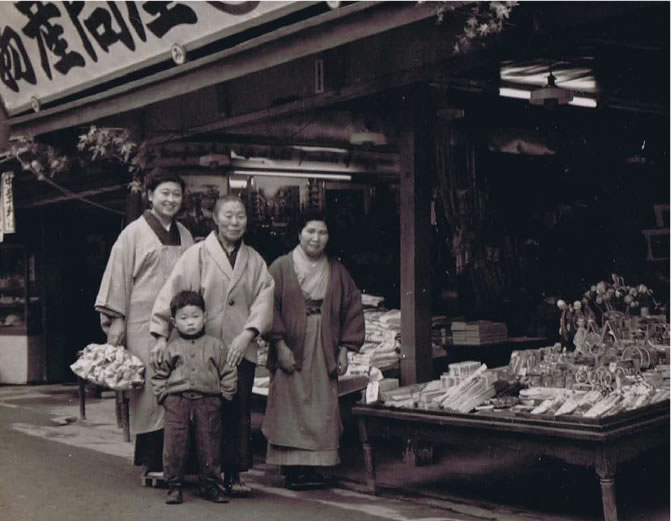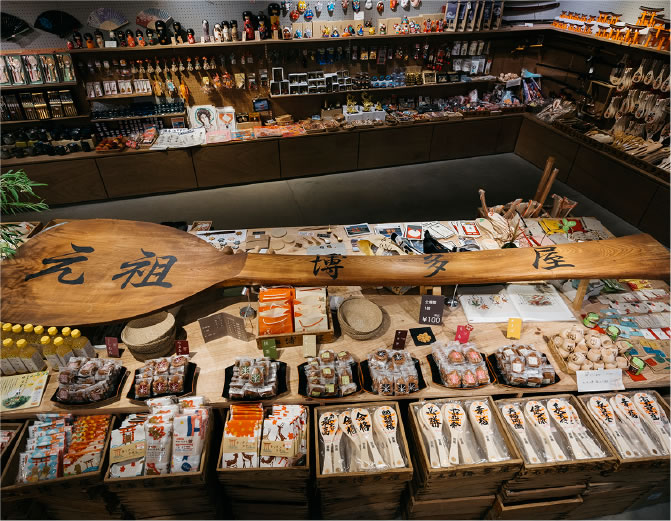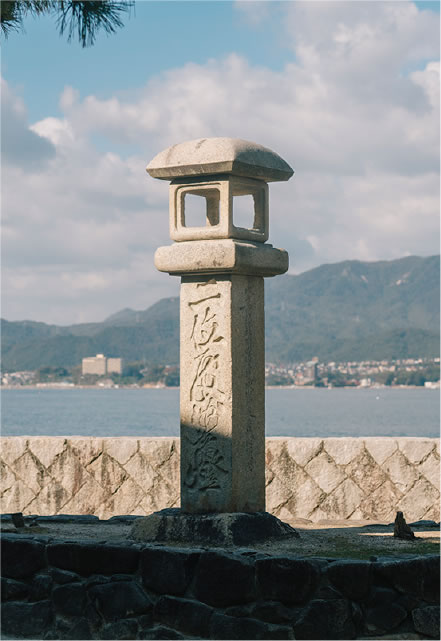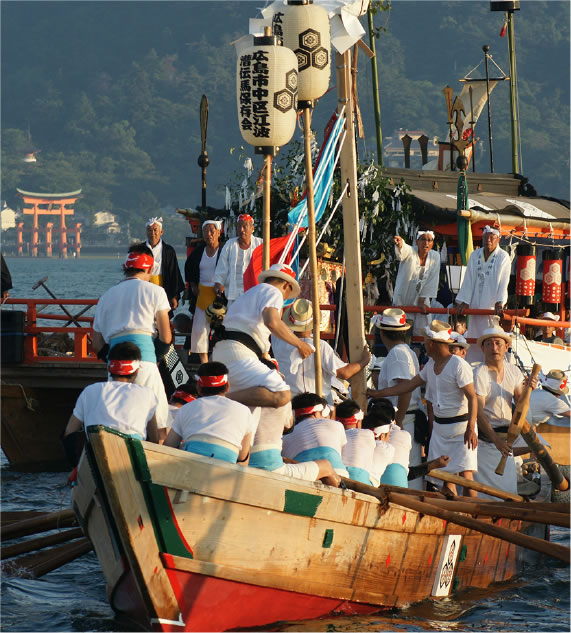博多屋についてABOUT
宮島の、風土のかたち。
THE SPECIAL FEATURES OF MIYAJIMA
明治初期創業 博多屋Founded in early Meiji HAKATAYA

博多屋は明治初期に宮島にて杓子問屋として創業しました。当時宮島の主要な工芸であった宮島杓子を広島県内のみならず全国に伝える役割を担いつつ、宮島厳島神社最大の神事、管絃祭の折には瀬戸内を渡る伝統の伝馬船「江波の漕ぎ伝馬」の乗り手たちの休み宿として地元の文化を支えてきました。
そんな宮島の変遷とともに、やがて宮島が誇る食文化「もみじまんじゅう」を生地や餡から自家製にこだわって製造する菓子舗へ。創業より140年の時を超え、もみじまんじゅうをはじめこの地の風土を新しい形に昇華し未来に伝えるデザインプロダクトの開発にも力を注いでいます。
Hakataya opened its doors in Miyajima as a rice scoop merchant in the early Meiji period. While playing the role of conveying Miyajima Shakushi rice scoops throughout Hiroshima Prefecture and all of Japan, Hakataya supported the local culture as a resting house for oarsmen of Eba’s ancient style rowboat that crossed the Seto Inland Sea to Miyajima for Itsukushima Shrine’s greatest ritual, the Kangensai. With the transition of Miyajima, Hakataya became a confectionery shop baking, from scratch with utmost care for all the ingredients, what eventually became the island’s signature food culture, Momiji Manju. More than 140 years since establishment, we continue to devote our efforts to Momiji Manju baking as we develop designer products that sublimate the special features of this land into new forms to pass on to the future.


博多屋の創業杓子SOGYO SHAKUSHI

博多屋が杓子卸売問屋として明治初期に創業後、看板として作られ、もみじ饅頭の製造を開始してからも、現在に至るまで大切に引き継がれてきたもの。一本の栓の木から木取りされた兄弟で、寄木ではない一本ものの杓子としては最大級の大きさを誇ります。
These shakushi were handcrafted as signboards when Hakataya opened its doors as a rice scoop merchant in the early Meiji period. The family treasures continued to be displayed when production of Momiji Manju began. The scoops are brothers carved from the same castor aralia tree and are the biggest of their kind made of solid wood.
宮島の、今のかたち。
MIYAJIMA TODAY
ここ宮島でしか味わえない味覚と体験Flavors and experiences
you can only experience here in Miyajima

創業以来、宮島の風土とともに歩んできた博多屋。ここ宮島という土地にこだわって、店舗でしか味わえないできたてのもみじまんじゅうや揚げたてのがんすをご提供しています。厳島神社への参拝や弥山登山、街をのんびりと歩く鹿とのふれあいなど、ここ宮島でしかできない体験とともに、博多屋の店舗でしか味わえない美味しさをどうぞ。
店舗北側に新たに竣工した多目的イベントスペース「アマノステラス」では、宮島の歴史、宮島の今、瀬戸内のカルチャーを未来に伝えるPOPUPを不定期開催。イベントスケジュールは「新着情報」ページをご覧ください。
Since our founding, Hakataya has grown hand-in-hand, with the special features of Miyajima. We pay particular attention to this place called Miyajima and offer freshly baked Momiji Manju and deep-fried Gansu for you to savor right in the shop as one of Miyajima’s unique experiences along with visiting the Itsukushima Shrine, climbing Mt. Misen, or befriending the deer on the streets.
Pop-up events relaying to the future the history of Miyajima, Miyajima today, or Seto Inland Sea culture will occasionally be held in the newly added Amanos Terrace on the north side. Please check the What’s New page for what’s happening.

宮島の、ときのかたち。
THE PASSING OF TIME IN MIYAJIMA
二位殿燈籠(にいどのとうろう)Nii-dono Toro

海岸に沿って宮島桟橋から厳島神社に行く途中、博多屋のほど近くの海外沿いにひと際凛とした佇まいの燈籠に出会います。二位の尼(にいのあま)とは平時子(平清盛の妻)。1185年の壇ノ浦の戦いで平家は源氏に敗れて、三種の神器とともに安徳天皇を抱いて海に身をなげ、その亡骸が宮島の有之浦に流れ着いたと言われています。そのことから、この一帯を「尼の洲」と呼ばれ、その名残として、「二位殿篭燈」はたっています。宮島の島民は供養するために神泉寺(場所は光明院の西側で現在は廃寺で神泉寺跡だけ残る)に阿弥陀堂を建て、二位の尼の木像を祀ったとされています。神泉寺は時を知らせる寺として、別名「時寺」と呼ばれました。杓子を考案した誓真が番僧をつとめたとしても有名です。
As you stroll along the coast from the Miyajima ferry port towards Itsukushima Shrine, you will encounter a stone lantern of dignified appearance just outside Hakataya. Nii-no-ama, whom the lantern is dedicated to, is Tokiko Taira, wife of Kiyomori. According to written history, when the Heike family was defeated by Genji in the Battle of Dannoura (1185), she threw herself into the sea, taking with her the Sacred Sword (one of the Three Imperial Regalia) and young Emperor Antoku in her arms. Her corpse was reportedly washed ashore at Arinoura Beach on Miyajima. Because of this, the area came to be called “Ama-no-su” and the Nii-dono lantern stands as a remnant. As a memorial, Miyajima Islanders built an Amida-dō (a hall enshrining Buddha) in Shinsenji (a temple west of Komyoin Temple) and worshiped Nii-no-ama’s wooden statue. Only the site remains today. Shinsenji was a temple that rang out the hours to notify the time and was also known as Tokidera (time temple). It is also famous for Seishin, the priest who invented the Miyajima Shakushi (rice scoop).


博多屋と厳島神社の管絃祭Hakataya and the Kangensai Festival
at Itsukushima Shrine

管絃祭(かんげんさい)は、潮の干満が最大となる旧暦6月17日に行われる厳島神社の祭礼行事で、天神祭(大阪府)、ホーランエンヤ(島根県)とともに日本三大船神事と言われています。平安の船遊びを今に伝え、広島湾全域を舞台とした壮大な祭り。博多屋は町屋の中で唯一、管絃祭御座船を引く江波漕伝馬の休憩所をつとめてまいりました。
The Kangensai, one of Japan’s three major boat rituals along with Osaka’s Tenjin-sai and Shimane’s Horan-enya, is a festival held at Itsukushima Shrine on June 17th of the lunar calendar, which usually falls between late July and early August. Set in the entire Hiroshima Bay area, it is a spectacular festival conveying the elegant floating entertainment of the Heian period. Hakataya is the only Machiya (merchant house) that has served as a resting place for the oarsmen from the fishing village of Eba, who tow the goza-bune boats with their ornamental vessel.
